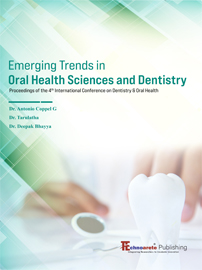


Senior lecturer, Chettinad Dental College and Research Institute, Kelambakkam, Chennai
Senior lecturer, Chettinad Dental College and Research Institute, Kelambakkam, Chennai
Postgraduate, Chettinad Dental College and Research Institute, Kelambakkam, Chennai
Postgraduate, Chettinad Dental College and Research Institute, Kelambakkam, Chennai
Postgraduate, Chettinad Dental College and Research Institute, Kelambakkam, Chennai;
Modern dentistry aims at preserving the tooth structure in a non- invasive manner. The transition from G V black’s “extension for prevention” to minimal intervention methods paved path for diagnosis of caries during the initial stages of demineralization. Initial caries lesion otherwise called as “white spot lesion” is a subsurface enamel demineralization occurring on the smooth surface of the teeth. “White spot lesion” – coined by FEJERSKOV et al. as – “the first sign of carious lesion that is visible to naked eye”. The white or chalky appearance of the white spot lesion is due to the difference in the scattering of light over the demineralized enamel. Apart from pre-disposing factors like microorganisms, diet and host factors, long term deposition of “undisturbed” plaque helps in the initiation of white spot lesion. These initial carious lesions appear after 4 weeks of demineralization The superficial layer of the enamel remains intact due to the protective action of the salivary proteins, Statherin. Since these salivary proteins are macromolecules, they will not penetrate into the subsurface layer of the enamel and thus its protective action remains confined to the superficial layers. Due to the continuous diffusion of acids, there will be decalcification in the subsurface layer of the enamel. The shape of the white spot lesion depends on the dissemination of the biofilm and enamel prism’s direction. Patients with fixed orthodontic appliance are prone for white spot lesions because of the difficulty in removal of plaque and more areas of “undisturbed” plaque retention. After the removal of appliance, remineralization of the lesion occurs, resulting in hard and shiny appearance of the surface area making the subsurface lesion less visible
[1] Mizrahi, E. (1983). Surface distribution of enamel opacities following orthodontic treatment. American Journal of Orthodontics 84, 323–331.
[2] Roopa KB, Pathak S, Poornima P, Neena IE. White spot lesions: A literature review. J Pediatr Dent 2015;3:1-7
[3] Silverstone LM, Hicks MJ, Featherstone MJ. Dynamic factors affecting lesion initiation and progression in human dental enamel. II. Surface morphology of sound enamel and carieslike lesions of enamel. Quintessence Int. 1988;19(11):773-785.
[4] Thylstrup, A., Bruun, C., and Holmen, L. (1994). In Vivo Caries Models-Mechanisms for Caries Initiation and Arrestment. Adv Dent Res. 8, 144–157
[5] Braga, M.M., Mendes, F.M., and Ekstrand, K.R. (2010). Detection Activity Assessment and Diagnosis of Dental Caries Lesions. Dental Clinics of North America 54, 479–493
[6] Tracy, Kyle & Dykstra, Bradley &Gakenheimer, David & Scheetz, James &Lacina, Stephani & Scarfe, William & Farman, Allan. (2011). Utility and effectiveness of computer aided diagnosis of dental caries. General dentistry. 59. 136-44..
[7] Ekstrand, K.R., Ricketts, D.N.J., Kidd, E.A.M., Qvist, V., and Schou, S. (1998). Detection, Diagnosing, Monitoring and Logical Treatment of Occlusal Caries in Relation to Lesion Activity and Severity: An in vivo Examination with Histological Validation. Caries Res 32, 247–254
[8] Thylstrup, A., Bruun, C., and Holmen, L. (1994). In Vivo Caries Models-Mechanisms for Caries Initiation and Arrestment. Adv Dent Res. 8, 144–157.
[9] Nyvad, B., and Baelum, V. (2018). Nyvad Criteria for Caries Lesion Activity and Severity Assessment: A Validated Approach for Clinical Management and Research. Caries Res 52, 397–405
[10] Bishara, S.E., and Ostby, A.W. (2008). White Spot Lesions: Formation, Prevention, and Treatment. Seminars in Orthodontics 14, 174–182
[11]Marinho, V.C., Chong, L.-Y., Worthington, H.V., and Walsh, T. (2016). Fluoride mouthrinses for preventing dental caries in children and adolescents. Cochrane Database of Systematic Reviews 2021
[12]Clinical AfairsCommiteeAAoPD. Fluoride therapy. Pediatric Dentistry. 2017;39: 242-245
[13]Jiang, H., Bian, Z., Tai, B.J., Du, M.Q., and Peng, B. (2005). The Effect of a Bi annual Professional Application of APF Foam on Dental Caries Increment in Primary Teeth: 24-month Clinical Trial. J Dent Res 84, 265–268.
[14] Reema SD, Lahiri PK, Roy SS. Review of casein phosphopeptides-amorphous calcium phosphate. The Chinese Journal of Dental Research : the Official Journal of the Scientific Section of the Chinese Stomatological Association (CSA). 2014 ;17(1):7-14.
[15]. Sitthisettapong, T., Doi, T., Nishida, Y., Kambara, M., and Phantumvanit, P. (2015). Effect of CPP-ACP Paste on Enamel Carious Lesion of Primary Upper Anterior Teeth Assessed by Quantitative Light-Induced Fluorescence: A One-Year Clinical Trial. Caries Res 49, 434–441.
[16] Huang, S.B., Gao, S.S., and Yu, H.Y. (2009). Effect of nano-hydroxyapatite concentration on remineralization of initial enamel lesion in vitro. Biomed. Mater. 4, 034104.
[17] Øgaard, B., Larsson, E., Henriksson, T., Birkhed, D., and Bishara, S.E. (2001). Effects of combined application of antimicrobial and fluoride varnishes in orthodontic patients. American Journal of Orthodontics and Dentofacial Orthopedics120, 28–35.
[18] Yazıcıoğlu . and Ulukapı . 4 . he investigation of non-invasive techniques for treating early approximal carious lesions: an in vivo study. International Dental Journal 64, 1–11.
[19]Näse, L., Hatakka, K., Savilahti, E., Saxelin, M., Pönkä, A., Poussa, T., Korpela, R., and Meurman, J.H. (2001). Effect of Long–Term Consumption of a Probiotic Bacterium, Lactobacillus rhamnosus GG, in Milk on Dental Caries and Caries Risk in Children. Caries Res 35, 412–420
[20]Donly, K.J., and Sasa, I.S. (2008). Potential Remineralization of Postorthodontic Demineralized Enamel and the Use of Enamel Microabrasion and Bleaching for Esthetics. Seminars in Orthodontics 14, 220–225